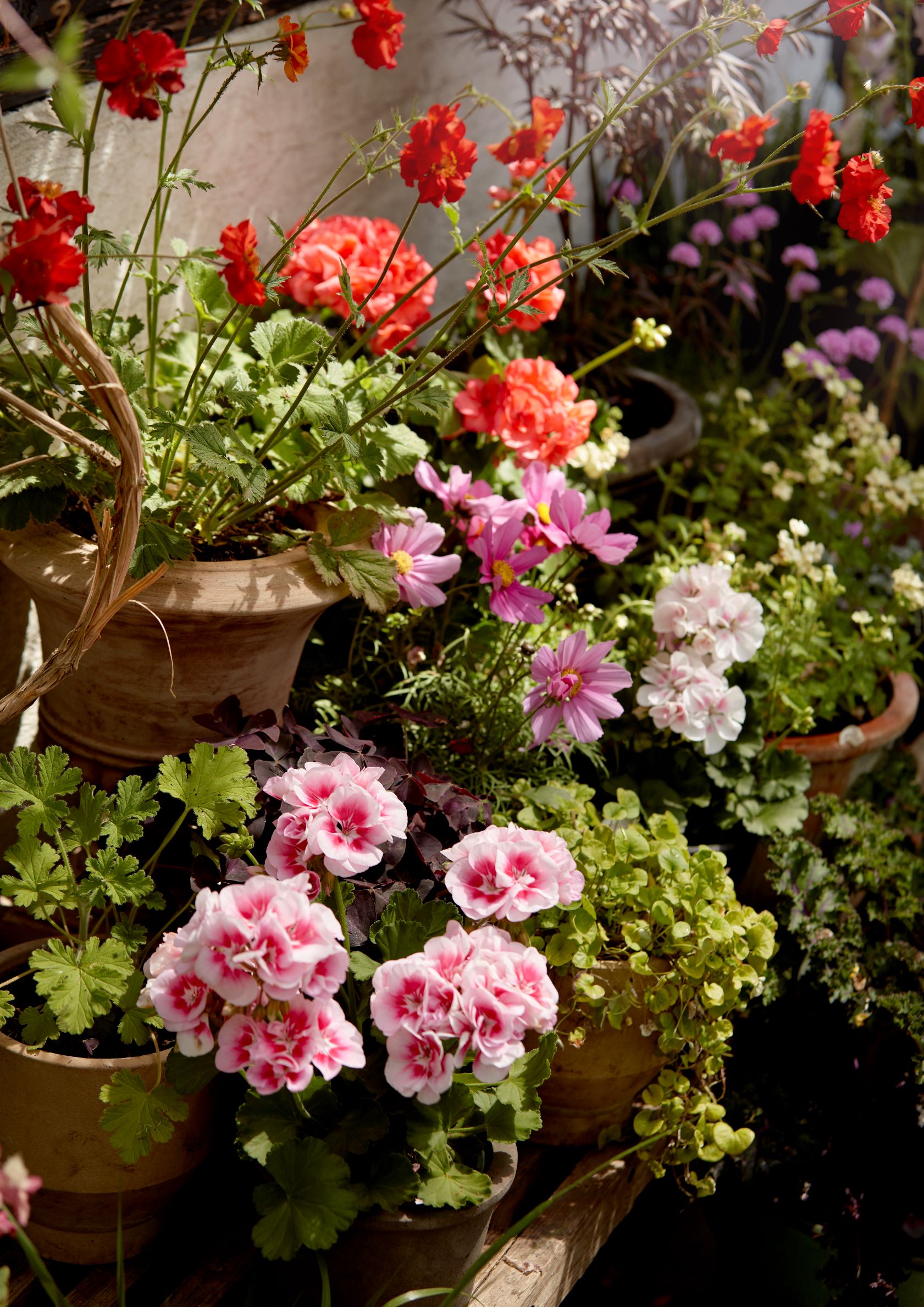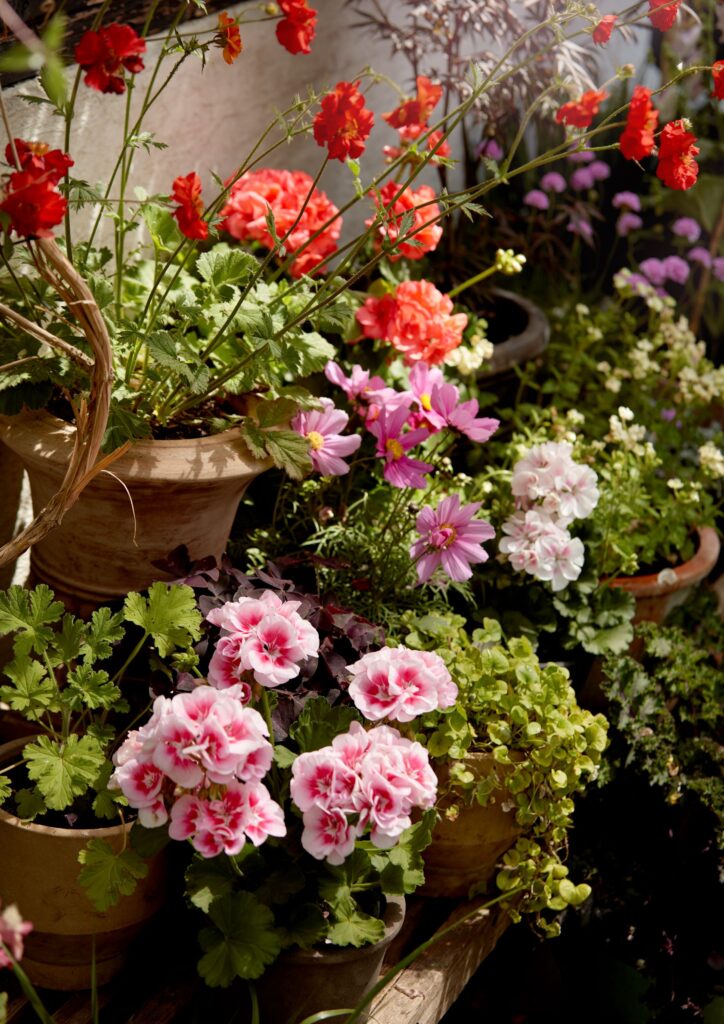 Pelargoniums are the undisputed stars of summertime. Fashions may come and go in the world of gardening, but whatever trends come to the fore in 2021, one thing’s for sure: these easy-to-grow plants will form the backbone of dazzling summer bedding displays, come rain or shine!
Pelargoniums are the undisputed stars of summertime. Fashions may come and go in the world of gardening, but whatever trends come to the fore in 2021, one thing’s for sure: these easy-to-grow plants will form the backbone of dazzling summer bedding displays, come rain or shine!
The timeless appeal of pelargoniums lies in the fact that they are true multi-taskers. They’ll thrive in a host of garden situations, regardless of how inhospitable the environment may be. From traditional flower beds and borders to hanging baskets, containers and window boxes, pelargoniums are renowned for their ability to flower profusely even if subjected to considerable neglect – injecting vibrant shades of red, mauve, white, orange and pink whether grown solo for stand-out impact or to ramp-up the drama in mixed planting schemes.
Pelargoniums’ enduring popularity, however, is not limited to the incredible choice of colours and styles that are widely available at nurseries and garden centres. These turbo-charged plants are quick off the mark, often blooming early in summer and keeping the show on the road late into autumn as the nights draw in, flowering long after other bedding stalwarts such as busy Lizzies, petunias and pansies have run out of steam and gone to seed. Although pelargoniums are not hardy enough to survive winter outdoors except in the mildest of microclimates, they’ll happily overwinter under cover.
In addition to their long flowering season, pelargoniums are growing in appeal as our climate warms up. These South African natives are tough cookies – one of the most drought-tolerant summer plants to grace our gardens, with a proven ability to remain unfazed by periods of intense heat. They offer superb performance during weather extremes that are becoming commonplace due to global warming, whether it’s a scorching heatwave or a downpour of biblical proportions. Pelargoniums also hold high appeal for the ease with which they fit into various garden styles, looking at home in traditional cottage garden planting as well as cutting-edge contemporary schemes. But wherever they take root, these cheery plants create a classic Mediterranean-style ambiance – a reminder to make the most of every minute that can be enjoyed outdoors during the warmer months.
Where is best to grow pelargoniums?
While pelargoniums are predominantly grown for their sheer flower-power, many types boast attractive foliage while some are even deliciously scented, with a choice of bushy, upright forms as well as trailing types that will cascade from heights. With so many options, it’s paramount to plant where displays will delight and dazzle in equal measure – think containers to adorn patios and decks, hanging baskets either side of doorways or flower beds that will be ablaze with a riot of colour.
Most varieties commonly on sale are sun worshippers that love to bask in summer heat, so grow in a bright, warm spot in full sun and you’ll maximise their flowering potential. If your garden benefits from a lack of direct sunlight, don’t despair, as regal pelargoniums will thank you for a partially shaded spot while varieties of zonal pelargoniums can be found that will grow happily in a degree of shade.
What soil or compost is best?
Pelargoniums take flower power to the next level when grown in nutrient-rich garden soil, so digging in well-rotted manure or garden compost a few weeks prior to planting will pay dividends. In containers, opt for a multi-purpose or John Innes No. 2 compost, while moisture-retaining tub and basket composts are recommended for areas that offer limited root space, such as hanging baskets and window boxes. Quality brands of compost should contain enough slow-release fertiliser to keep plants happy for at least a month.
Do pelargoniums need feeding?
Pelargoniums have an enviable reputation for hassle-free performance but as with all summertime stars they’ll reward you with a show-stopping display of blooms if fed regularly. Fortnightly feeding once flowering has started, using a balanced liquid fertiliser during the growing season, will ensure that plants flourish and repeat-flower non-stop – or use a high potassium fertiliser such as tomato food, which is formulated encourage a profusion of blooms. For best results, liquid feed when the compost or soil is moist, as run-off will be reduced and roots will be able to absorb the nutrients.
Is dead-heading necessary?
Regular dead-heading – snipping off spent blooms – encourages plants to channel all their energy into producing more flowers, ensuring that displays keep going into autumn. It’s worth also removing withered shoots and damaged leaves, to keep plants looking at their prime. Dead-heading once a week is easy and takes a matter of seconds.
How often should pelargoniums be watered?
While pelargoniums are drought-tolerant, regular summer watering – daily during hot spells – holds the key to a display to be proud of. The golden rule is to ensure that compost is not allowed to become parched, nor should it be saturated with water. It’s important to remember that pelargoniums are dense, bushy plants and their canopy can repel downpours, preventing water from reaching compost in plant-packed containers. For best results, use rainwater collected from water butts, and water first thing in the morning or just before dusk, when temperatures are cooler and roots have time to absorb the moisture (watering in the heat of the day risks scorching foliage while much of the water can be lost to evaporation). Where gardeners are not at home every day to keep plants irrigated, self-watering planters that contain a built-in reservoir are a bonus.
Are pelargoniums at risk from pests?
Great news – pelargoniums are largely pest free! They’re especially resilient to the number one plant-wrecker, slugs and snails, which find their fleshy leaves and thick-walled stems unpalatable. Rot such as grey mould can be an issue in wet, warm summers if plants are crammed too close together, so space plants at least 20cm apart to promote good air flow and reduce the risk of trouble. Aphid damage is rare, but infestations can quickly and easily be eradicated using an organic bug killer.
Can pelargoniums be overwintered?
Bring plants indoors before the first frosts of autumn, potting up into John Innes No. 1 compost and cutting growth back to a height of around 15cm. Overwinter in a light, cool location where temperatures drop no lower than 5-10oC and water sparingly, keeping compost on the dry side. A bright frost-free porch, conservatory or a window sill in a cool room is ideal. Warmer temperatures in spring combined with an increase in watering will spur plants into putting on new growth.
Find out more
To find out more about Pelargonium for Europe, and to access its incredible library of advice, aspirational imagery and content please visit https://www.pelargoniumforeurope.com/
NOTES TO EDITORS
Pelargonium for Europe is the marketing initiative of European geranium breeders Dümmen Orange,Elsner PAC, Florensis / P. van der Haak Handelskwekerij, Geranien Endisch, Selecta One and SyngentaFlowers. The initiative was founded in 2016 with the aim of promoting and securing long-termgeranium sales in Europe. Its activities began in 2017 and in Germany, Austria, France, Italy, theNetherlands and Poland, activities are supported by the EU as part of the “Europe in Bloom” campaign.
Press contact
Pelargonium for Europe UK press office
Hornby Whitefoot PR
Phone: 07851 610573
Mail: kimberley@hornbywhitefootpr.co.uk
Web: www.pelargoniumforeurope.com

